Burden of Proof in a Case Study on Human Resource Management
VerifiedAdded on 2023/01/06
|6
|1410
|57
AI Summary
This case study examines the burden of proof in a human resource management case and the interpretation of a labor agreement. It discusses the reasons for discharge, contract interpretation issues, general guidelines for subcontracting, and the clause of the labor agreement. The study also considers the union representation statistics for different states and provides an arbitrator's ruling.
Contribute Materials
Your contribution can guide someone’s learning journey. Share your
documents today.

Running Head: CASE STUDY 0
Human Resource Managment
Human Resource Managment
Secure Best Marks with AI Grader
Need help grading? Try our AI Grader for instant feedback on your assignments.
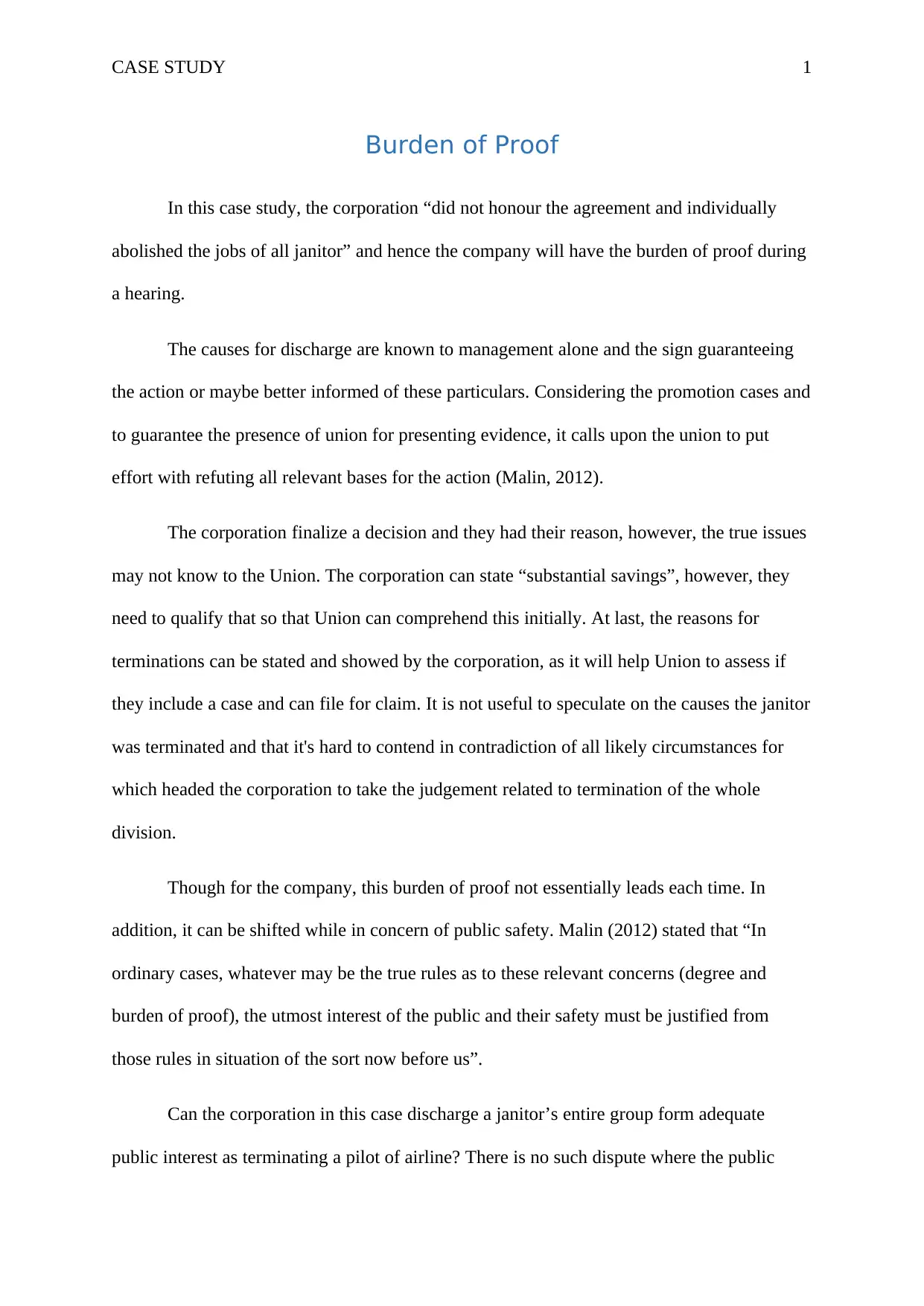
CASE STUDY 1
Burden of Proof
In this case study, the corporation “did not honour the agreement and individually
abolished the jobs of all janitor” and hence the company will have the burden of proof during
a hearing.
The causes for discharge are known to management alone and the sign guaranteeing
the action or maybe better informed of these particulars. Considering the promotion cases and
to guarantee the presence of union for presenting evidence, it calls upon the union to put
effort with refuting all relevant bases for the action (Malin, 2012).
The corporation finalize a decision and they had their reason, however, the true issues
may not know to the Union. The corporation can state “substantial savings”, however, they
need to qualify that so that Union can comprehend this initially. At last, the reasons for
terminations can be stated and showed by the corporation, as it will help Union to assess if
they include a case and can file for claim. It is not useful to speculate on the causes the janitor
was terminated and that it's hard to contend in contradiction of all likely circumstances for
which headed the corporation to take the judgement related to termination of the whole
division.
Though for the company, this burden of proof not essentially leads each time. In
addition, it can be shifted while in concern of public safety. Malin (2012) stated that “In
ordinary cases, whatever may be the true rules as to these relevant concerns (degree and
burden of proof), the utmost interest of the public and their safety must be justified from
those rules in situation of the sort now before us”.
Can the corporation in this case discharge a janitor’s entire group form adequate
public interest as terminating a pilot of airline? There is no such dispute where the public
Burden of Proof
In this case study, the corporation “did not honour the agreement and individually
abolished the jobs of all janitor” and hence the company will have the burden of proof during
a hearing.
The causes for discharge are known to management alone and the sign guaranteeing
the action or maybe better informed of these particulars. Considering the promotion cases and
to guarantee the presence of union for presenting evidence, it calls upon the union to put
effort with refuting all relevant bases for the action (Malin, 2012).
The corporation finalize a decision and they had their reason, however, the true issues
may not know to the Union. The corporation can state “substantial savings”, however, they
need to qualify that so that Union can comprehend this initially. At last, the reasons for
terminations can be stated and showed by the corporation, as it will help Union to assess if
they include a case and can file for claim. It is not useful to speculate on the causes the janitor
was terminated and that it's hard to contend in contradiction of all likely circumstances for
which headed the corporation to take the judgement related to termination of the whole
division.
Though for the company, this burden of proof not essentially leads each time. In
addition, it can be shifted while in concern of public safety. Malin (2012) stated that “In
ordinary cases, whatever may be the true rules as to these relevant concerns (degree and
burden of proof), the utmost interest of the public and their safety must be justified from
those rules in situation of the sort now before us”.
Can the corporation in this case discharge a janitor’s entire group form adequate
public interest as terminating a pilot of airline? There is no such dispute where the public
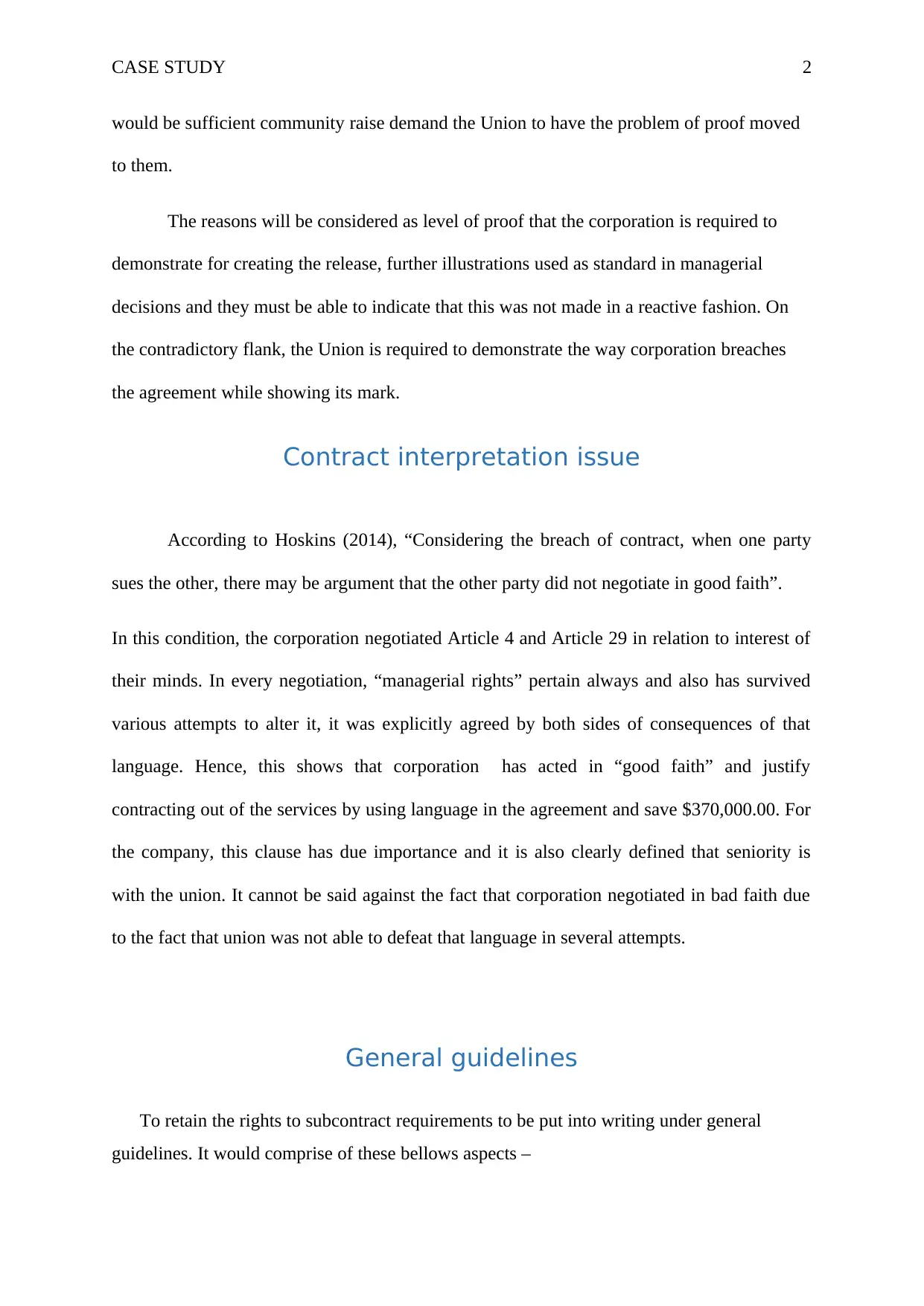
CASE STUDY 2
would be sufficient community raise demand the Union to have the problem of proof moved
to them.
The reasons will be considered as level of proof that the corporation is required to
demonstrate for creating the release, further illustrations used as standard in managerial
decisions and they must be able to indicate that this was not made in a reactive fashion. On
the contradictory flank, the Union is required to demonstrate the way corporation breaches
the agreement while showing its mark.
Contract interpretation issue
According to Hoskins (2014), “Considering the breach of contract, when one party
sues the other, there may be argument that the other party did not negotiate in good faith”.
In this condition, the corporation negotiated Article 4 and Article 29 in relation to interest of
their minds. In every negotiation, “managerial rights” pertain always and also has survived
various attempts to alter it, it was explicitly agreed by both sides of consequences of that
language. Hence, this shows that corporation has acted in “good faith” and justify
contracting out of the services by using language in the agreement and save $370,000.00. For
the company, this clause has due importance and it is also clearly defined that seniority is
with the union. It cannot be said against the fact that corporation negotiated in bad faith due
to the fact that union was not able to defeat that language in several attempts.
General guidelines
To retain the rights to subcontract requirements to be put into writing under general
guidelines. It would comprise of these bellows aspects –
would be sufficient community raise demand the Union to have the problem of proof moved
to them.
The reasons will be considered as level of proof that the corporation is required to
demonstrate for creating the release, further illustrations used as standard in managerial
decisions and they must be able to indicate that this was not made in a reactive fashion. On
the contradictory flank, the Union is required to demonstrate the way corporation breaches
the agreement while showing its mark.
Contract interpretation issue
According to Hoskins (2014), “Considering the breach of contract, when one party
sues the other, there may be argument that the other party did not negotiate in good faith”.
In this condition, the corporation negotiated Article 4 and Article 29 in relation to interest of
their minds. In every negotiation, “managerial rights” pertain always and also has survived
various attempts to alter it, it was explicitly agreed by both sides of consequences of that
language. Hence, this shows that corporation has acted in “good faith” and justify
contracting out of the services by using language in the agreement and save $370,000.00. For
the company, this clause has due importance and it is also clearly defined that seniority is
with the union. It cannot be said against the fact that corporation negotiated in bad faith due
to the fact that union was not able to defeat that language in several attempts.
General guidelines
To retain the rights to subcontract requirements to be put into writing under general
guidelines. It would comprise of these bellows aspects –
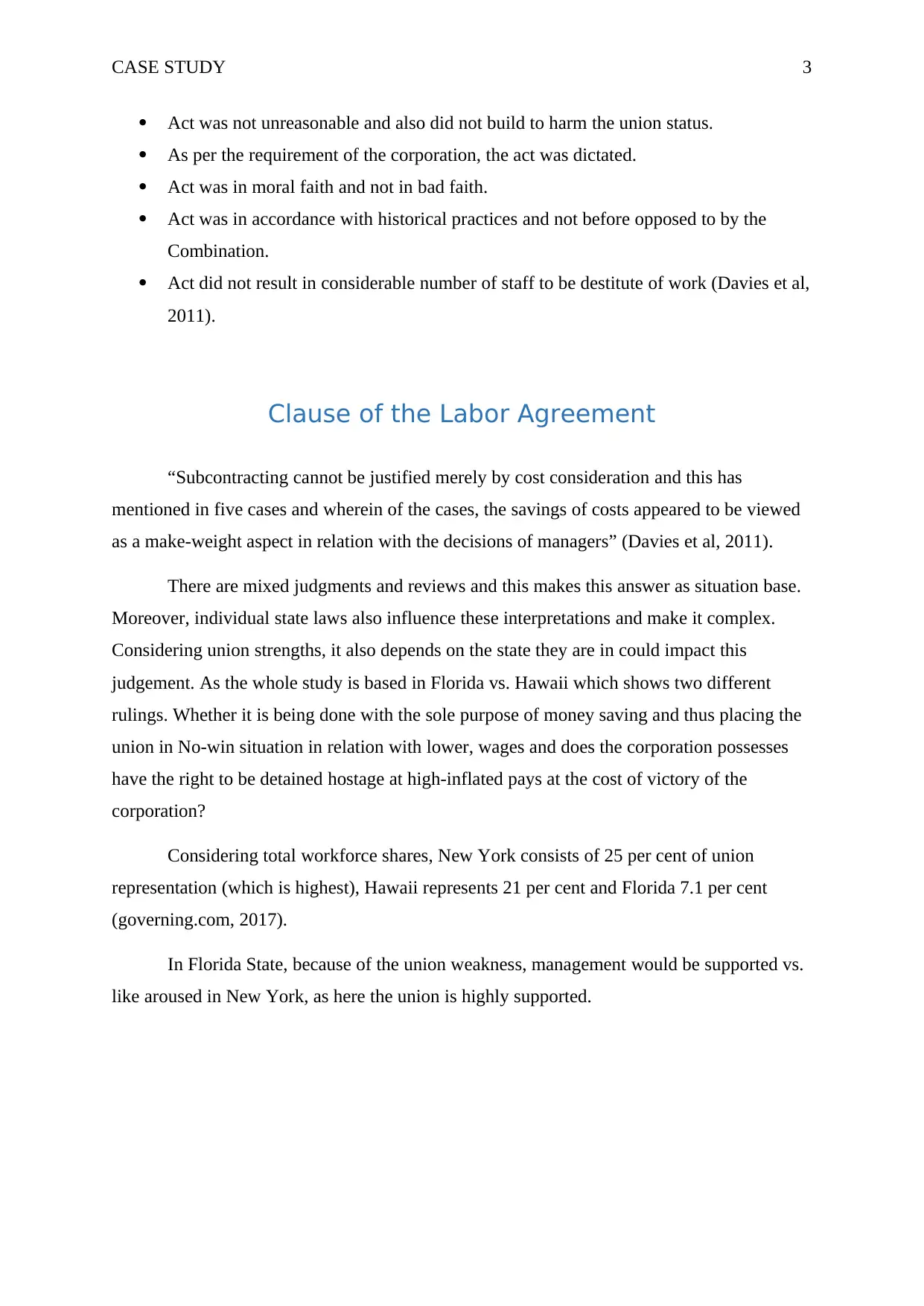
CASE STUDY 3
Act was not unreasonable and also did not build to harm the union status.
As per the requirement of the corporation, the act was dictated.
Act was in moral faith and not in bad faith.
Act was in accordance with historical practices and not before opposed to by the
Combination.
Act did not result in considerable number of staff to be destitute of work (Davies et al,
2011).
Clause of the Labor Agreement
“Subcontracting cannot be justified merely by cost consideration and this has
mentioned in five cases and wherein of the cases, the savings of costs appeared to be viewed
as a make-weight aspect in relation with the decisions of managers” (Davies et al, 2011).
There are mixed judgments and reviews and this makes this answer as situation base.
Moreover, individual state laws also influence these interpretations and make it complex.
Considering union strengths, it also depends on the state they are in could impact this
judgement. As the whole study is based in Florida vs. Hawaii which shows two different
rulings. Whether it is being done with the sole purpose of money saving and thus placing the
union in No-win situation in relation with lower, wages and does the corporation possesses
have the right to be detained hostage at high-inflated pays at the cost of victory of the
corporation?
Considering total workforce shares, New York consists of 25 per cent of union
representation (which is highest), Hawaii represents 21 per cent and Florida 7.1 per cent
(governing.com, 2017).
In Florida State, because of the union weakness, management would be supported vs.
like aroused in New York, as here the union is highly supported.
Act was not unreasonable and also did not build to harm the union status.
As per the requirement of the corporation, the act was dictated.
Act was in moral faith and not in bad faith.
Act was in accordance with historical practices and not before opposed to by the
Combination.
Act did not result in considerable number of staff to be destitute of work (Davies et al,
2011).
Clause of the Labor Agreement
“Subcontracting cannot be justified merely by cost consideration and this has
mentioned in five cases and wherein of the cases, the savings of costs appeared to be viewed
as a make-weight aspect in relation with the decisions of managers” (Davies et al, 2011).
There are mixed judgments and reviews and this makes this answer as situation base.
Moreover, individual state laws also influence these interpretations and make it complex.
Considering union strengths, it also depends on the state they are in could impact this
judgement. As the whole study is based in Florida vs. Hawaii which shows two different
rulings. Whether it is being done with the sole purpose of money saving and thus placing the
union in No-win situation in relation with lower, wages and does the corporation possesses
have the right to be detained hostage at high-inflated pays at the cost of victory of the
corporation?
Considering total workforce shares, New York consists of 25 per cent of union
representation (which is highest), Hawaii represents 21 per cent and Florida 7.1 per cent
(governing.com, 2017).
In Florida State, because of the union weakness, management would be supported vs.
like aroused in New York, as here the union is highly supported.
Secure Best Marks with AI Grader
Need help grading? Try our AI Grader for instant feedback on your assignments.
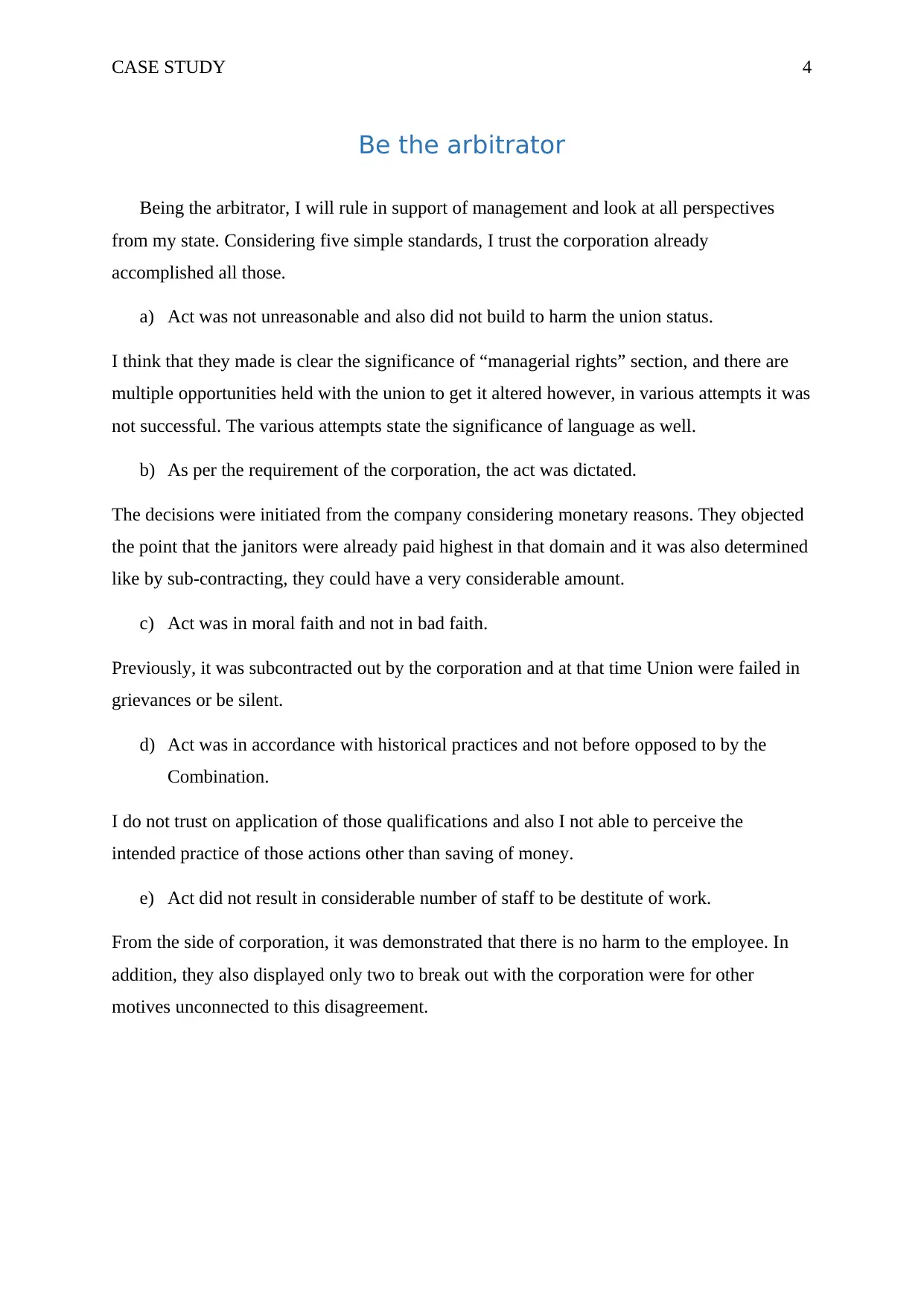
CASE STUDY 4
Be the arbitrator
Being the arbitrator, I will rule in support of management and look at all perspectives
from my state. Considering five simple standards, I trust the corporation already
accomplished all those.
a) Act was not unreasonable and also did not build to harm the union status.
I think that they made is clear the significance of “managerial rights” section, and there are
multiple opportunities held with the union to get it altered however, in various attempts it was
not successful. The various attempts state the significance of language as well.
b) As per the requirement of the corporation, the act was dictated.
The decisions were initiated from the company considering monetary reasons. They objected
the point that the janitors were already paid highest in that domain and it was also determined
like by sub-contracting, they could have a very considerable amount.
c) Act was in moral faith and not in bad faith.
Previously, it was subcontracted out by the corporation and at that time Union were failed in
grievances or be silent.
d) Act was in accordance with historical practices and not before opposed to by the
Combination.
I do not trust on application of those qualifications and also I not able to perceive the
intended practice of those actions other than saving of money.
e) Act did not result in considerable number of staff to be destitute of work.
From the side of corporation, it was demonstrated that there is no harm to the employee. In
addition, they also displayed only two to break out with the corporation were for other
motives unconnected to this disagreement.
Be the arbitrator
Being the arbitrator, I will rule in support of management and look at all perspectives
from my state. Considering five simple standards, I trust the corporation already
accomplished all those.
a) Act was not unreasonable and also did not build to harm the union status.
I think that they made is clear the significance of “managerial rights” section, and there are
multiple opportunities held with the union to get it altered however, in various attempts it was
not successful. The various attempts state the significance of language as well.
b) As per the requirement of the corporation, the act was dictated.
The decisions were initiated from the company considering monetary reasons. They objected
the point that the janitors were already paid highest in that domain and it was also determined
like by sub-contracting, they could have a very considerable amount.
c) Act was in moral faith and not in bad faith.
Previously, it was subcontracted out by the corporation and at that time Union were failed in
grievances or be silent.
d) Act was in accordance with historical practices and not before opposed to by the
Combination.
I do not trust on application of those qualifications and also I not able to perceive the
intended practice of those actions other than saving of money.
e) Act did not result in considerable number of staff to be destitute of work.
From the side of corporation, it was demonstrated that there is no harm to the employee. In
addition, they also displayed only two to break out with the corporation were for other
motives unconnected to this disagreement.
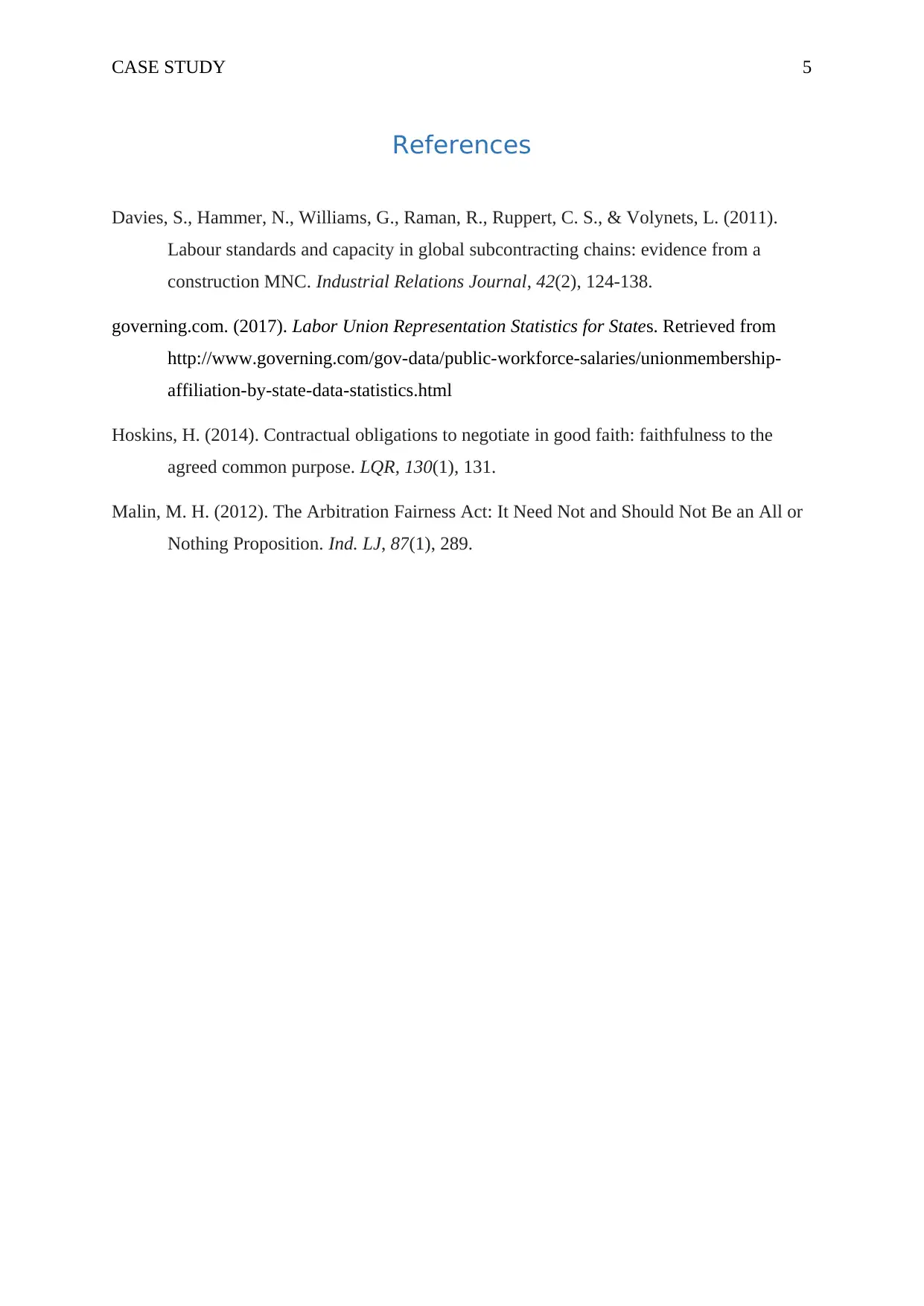
CASE STUDY 5
References
Davies, S., Hammer, N., Williams, G., Raman, R., Ruppert, C. S., & Volynets, L. (2011).
Labour standards and capacity in global subcontracting chains: evidence from a
construction MNC. Industrial Relations Journal, 42(2), 124-138.
governing.com. (2017). Labor Union Representation Statistics for States. Retrieved from
http://www.governing.com/gov-data/public-workforce-salaries/unionmembership-
affiliation-by-state-data-statistics.html
Hoskins, H. (2014). Contractual obligations to negotiate in good faith: faithfulness to the
agreed common purpose. LQR, 130(1), 131.
Malin, M. H. (2012). The Arbitration Fairness Act: It Need Not and Should Not Be an All or
Nothing Proposition. Ind. LJ, 87(1), 289.
References
Davies, S., Hammer, N., Williams, G., Raman, R., Ruppert, C. S., & Volynets, L. (2011).
Labour standards and capacity in global subcontracting chains: evidence from a
construction MNC. Industrial Relations Journal, 42(2), 124-138.
governing.com. (2017). Labor Union Representation Statistics for States. Retrieved from
http://www.governing.com/gov-data/public-workforce-salaries/unionmembership-
affiliation-by-state-data-statistics.html
Hoskins, H. (2014). Contractual obligations to negotiate in good faith: faithfulness to the
agreed common purpose. LQR, 130(1), 131.
Malin, M. H. (2012). The Arbitration Fairness Act: It Need Not and Should Not Be an All or
Nothing Proposition. Ind. LJ, 87(1), 289.
1 out of 6
Your All-in-One AI-Powered Toolkit for Academic Success.
+13062052269
info@desklib.com
Available 24*7 on WhatsApp / Email
![[object Object]](/_next/static/media/star-bottom.7253800d.svg)
Unlock your academic potential
© 2024 | Zucol Services PVT LTD | All rights reserved.